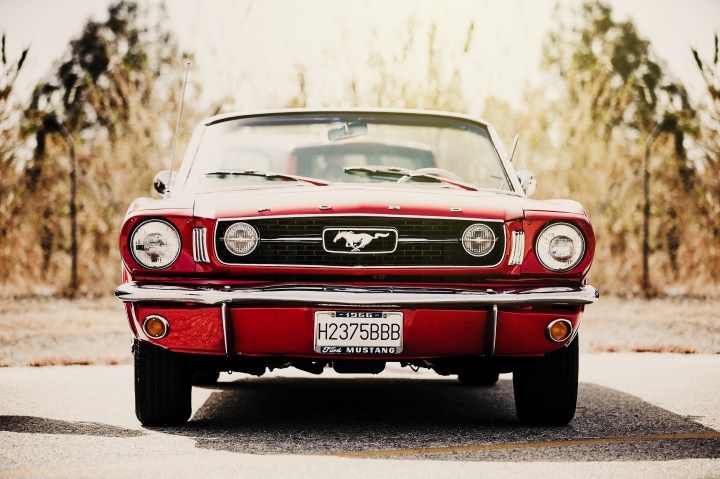
Why do so many women drive Ford Mustangs?

This is just one of the stories from our “I’ve Always Wondered” series, where we tackle all of your questions about the world of business, no matter how big or small. Ever wondered if recycling is worth it? Or how store brands stack up against name brands? Check out more from the series here.
Listener Jason Mudd from Amelia Island, Florida, asks:
Is there a proclivity for women to drive Ford Mustangs? And if so, why?
Isabelle Bolla, a 31-year-old Ford Mustang owner in Los Angeles, took an interest in Mustangs after seeing the historic car zoom across the screen in “Goldfinger,” a James Bond flick with Sean Connery.
“I was young and very impressionable, and I just fell in love with it,” Bolla said.
The car had been on her wish list since what seemed like forever. Finally, in early 2020, she bought her first Mustang — a 1967 coupe that she spent a year restoring.
The Mustang, introduced in 1964, was targeted toward female buyers when it debuted. Women represent more than a fifth of Mustang buyers, according to Joe Bellino, Mustang brand manager at Ford.
The car line’s approachability, stylish design, recognizability and wide variety of options have made it a popular choice among women, according to car experts and women who own Mustangs.
“Once you’re in it, it rewards you with performance and it rewards you with style and it rewards you with being noticed,” said Natalie Neff, the editor of Autoweek.
An enduring appeal
For decades, the Mustang brand has carried cachet.
“Mustang is the single most iconic, classic, cool nameplate out there,” Neff said. “Women want cool cars as much as anybody.”
Elana Scherr, senior editor at Car and Driver, echoed that sentiment and recalled that when she was in college, a roommate of hers had an ‘80s Mustang.
“She looked cool, man,” Scherr said. The car stood out compared to the vehicles her other friends drove.

“You’re not going to see somebody in a Mustang and be like, ‘Ugh. Boring, lame,’” Scherr said. “There’s some level of personality already just in the car they chose.”
The Mustang also comes in a range of variations.
“There’s sort of this big spread where someone can be a really macho drag racer and get a Mustang, or someone can just want to commute to work in a four-cylinder and they can also get a Mustang,” Scherr said. “You can get street cred without having to suffer through some sort of ferocious, too-fast car. But then, if you do want a fast car, you can get that all under the same name.”
Jillian Nance, a 21-year-old who lives in Madison, Alabama, said she purchased her 2005 V6 Mustang because she wanted to drive a sports car, but she and her dad agreed she shouldn’t get one that’s too powerful.
“It’s not something so crazy where I’m gonna run it off the road,” Nance said.
Neff said the Mustang remains an attractive option because there aren’t many convertibles out there anymore and they’re affordable. You can get a new one for about $30,000, while the average price of a new car in December was over $48,700, according to Kelley Blue Book.
Or, like Jillian Nance and Isabelle Bolla, you can get even cheaper deals if you buy them used.
Nance said she bought hers for $5,500, and Bolla said she got hers for somewhere between $4,000 and $6,000.

Bolla said she did spend about $25,000 restoring the car, but she was able to get $6,000 to $7,000 back by selling some of the parts. The price tag would’ve been even higher if she had it professionally restored.
“Now it’s transformed back to its original color, which I discovered through looking up information on it is a very beautiful dark green,” Bolla said. “Pretty much almost everything on the car has been replaced or updated.”
With the restoration, Bolla said, she’s been able to turn her Mustang into a car that reflects her own style.
A history of marketing to women
Ford targeted the Mustang at women in the car’s early days, according to Neff and Scherr.
“They specifically sought out women buyers for it, which you can’t say about a lot of ‘cool’ cars,” Neff said.
One commercial featured a woman getting into the driver’s seat of a Mustang, with a voiceover saying you can afford it on “a secretary’s salary.” The driver, who’s described as single, is sitting in the car envisioning herself in various presumably fulfilling scenarios — winning a beauty pageant as Miss Mustang 66, succeeding as an Olympic diver, getting married.
Another woman, who says she really should be in the kitchen, can’t resist taking one for a test drive.
Ford and Tussy Cosmetics collaborated on a national sweepstakes that offered women the chance to win a Mustang in one of three shades of pink. An ad describing details of the contest features a woman on the hood of a Mustang with the slogan, “Wear a Mustang to match your lipstick.”
Scherr said Ford’s original ads seem sexist now, but at the time they helped women feel seen.
Because of Ford’s long history in the U.S., there’s a “baked-in fluency” or shared language surrounding the Mustang, Neff said, which makes it easier for people to join in the car talk.
And the car, which has been in continuous production since its launch, has always been recognizable, Scherr said.
“It’s like the Stanley cup of cars. If someone says, ‘I have a Mustang,’ you know what that looks like,” she noted.
On the other hand, if you tell someone you have a Jensen Interceptor, Scherr added, people are less likely to know what you’re referring to.
“When you think about women shopping for cars, none of us want to be seen as stupid,” Scherr said. “If you know a name, if you know something to ask for, then you can come in with a little bit more power.”
Scherr said that means you can walk in and say, “I want to see the Mustang. I want to test drive a Mustang,” instead of just saying, “I want to test drive a car.”
All generations behind the wheel
Despite its debut about 60 years ago, the Mustang still attracts the interest of younger buyers, like Nance and Bolla.

The license plate on Nance’s model reads “lil pony,” since a real mustang, of course, is a pony, and hers has a V6 engine instead of a V8.
“So all my friends, like, no joke, will call me ‘lil pony,’ and I turn around and respond to that,” she said.
One of her most memorable moments driving her Mustang, whom she’s named Ryker, occurred when she went with friends up to Tail of the Dragon, an 11-mile road at the North Carolina-Tennessee border with 318 curves.
“Being able to drive that with my friends was just an awesome experience because I had never pushed my car that hard,” Nance said.
In some cases, buying a Mustang comes with exciting opportunities to see your car in the spotlight.
Bolla said her Mustang was featured in a Men’s Health photoshoot with Jeremy Renner. On another occasion, she lent it to a female stunt driver, who drove it around a race course and performed donuts.
“She really made my car look incredible,” Bolla said.
Bolla described the Mustang community as “vibrant,” filled with knowledgeable owners. She’s had the chance to talk to women of all different ages and backgrounds.
“It’s been a really big pleasure for me to meet a lot of other women who have classic Mustangs, or Fords even,” Bolla said.
There’s a lot happening in the world. Through it all, Marketplace is here for you.
You rely on Marketplace to break down the world’s events and tell you how it affects you in a fact-based, approachable way. We rely on your financial support to keep making that possible.
Your donation today powers the independent journalism that you rely on. For just $5/month, you can help sustain Marketplace so we can keep reporting on the things that matter to you.


















